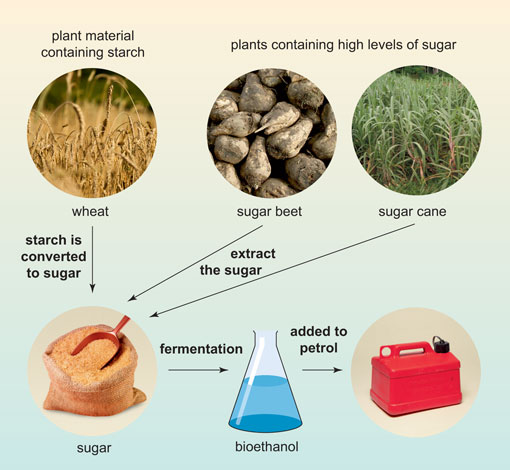Biofuels
Use 'Print preview' to check the number of pages and printer settings.
Print functionality varies between browsers.
Printable page generated Wednesday, 24 April 2024, 4:09 PM
Biofuels
Introduction
This course looks at biofuels, which are sources of energy that come from material that was recently living. This energy is derived from the process of photosynthesis where the plant uses the energy from sunlight to allow it to take carbon dioxide gas from the atmosphere and convert it into sugars and into the carbon containing structures within the plant. These structures can, for instance, be burned to release the energy they contain. Therefore, burning a biofuel releases carbon dioxide that was trapped only a few years beforehand and so is said to be 'carbon neutral', whereas burning a fossil fuel releases both the energy and carbon dioxide that was trapped millions of year before and can lead to global warming. Wood and certain types of grass can be used as biofuels. Plants that contain large amounts of sugar or oil can be used to produce bioethanol or biodiesel, which are important transport biofuels.
This OpenLearn course provides a sample of level 1 study in Science
Learning outcomes
After studying this course, you should be able to:
demonstrate general knowledge and understanding of some of the basic facts, language, concepts and principles relating to plants, in particular the composition and properties of plants and the different ways in which plant products have been utilised by humans
demonstrate an understanding of the contribution that science can make to informed debate on issues arising from the use of plants and the threats posed to plants and their habitats
make sense of information presented in different ways, including textual, numerical, graphical, multimedia and web-based material.
1 What are biofuels?
The use of biological material (biomass) as a fuel or lighting material is not new; the earliest evidence for humans using wood for fires is at Gesher Benot Ya'aqov in Israel, 790,000 years ago. However, concern over the impact that the burning of fossil fuels is potentially having on the climate has resulted in renewed interest in biofuels. The difference between fossil fuels and biofuels is that fossil fuels were produced millions of years ago when plants and other organisms died, became buried and were subjected to high temperatures and pressures forming coal, oil or natural gas. Biofuels, on the other hand, are produced from biological material that has been living recently. There are a number of ways in which biofuels can be produced.
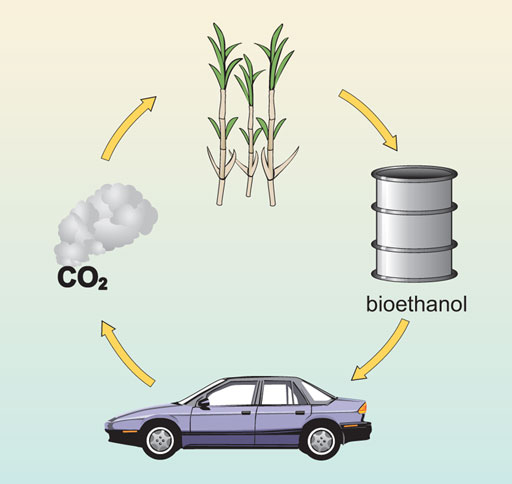
Some biofuels can be produced from waste material, such as recycled plant oils, whilst others can be produced from plants specially grown for the purpose. Both liquid and gaseous forms of biofuels can be produced from crops that either have a high sugar content, such as sugar cane or sugar beet, or contain starch that can be converted into sugars, such as maize. Plants containing high levels of plant oils, such as oil palm or soybean, can also be used. Wood and its by-products can be converted into a variety of biofuels.
In this course you will learn about how plants are used to provide energy for use by humans.
Question 1
What are the main ways in which humans use energy?
Answer
Energy is needed for heat, light, power and transport.
Question 2
Which fuels provide this energy?
Answer
Coal, oil, gas, petrol, diesel, wood, peat and uranium (for nuclear power); other than uranium, all these fuels are derived directly or indirectly from plants.
Question 3
What are the properties of a good fuel?
Answer
First and foremost it should be capable of providing lots of energy and be relatively cheap. Factors which affect the cost of the fuel include: the ease of transport, for instance it is much easier to transport liquids (petrol, oil and diesel) and gases (natural gas) than it is solids (such as coal); the ease of extraction and the processing costs.
Question 4
List the uses that you personally make of different fuels.
Answer
You may use petrol or diesel to power a car, natural gas or electricity to cook with or to heat your home, wood burnt in an open fire and electricity for lighting. The chances are that the electricity you use was generated by burning coal or from nuclear power.
2 Energy from plants and climate change
Plants capture carbon dioxide (CO2) during photosynthesis and store it in their tissues in a variety of carbon compounds (including both carbohydrates and oils). These are often energy stores for the plant but they can also be harvested and processed to provide energy for human use.
| Energy store | Energy (megajoules per kilogram) |
| Plant oil | 37 |
| Coal | 24 |
| Carbohydrates (including sugars) | 17 |
| Wood (dry) | 16 |
1 megajoule is roughly the amount of energy that a one-bar electric fire would emit in 15 minutes. (Note that if wood has not been seasoned to remove excess water, less energy is obtained because some of the energy is used to heat and evaporate the water.)
Question 5
From Table 1, which of the energy stores releases the most energy and which the least energy per kilogramme?
Answer
Most: Plant oil (37 megajoules per kilogram)
Least: Wood (dry) (16 megajoules per kilogram)
At present, most of our energy comes from fossil fuels which originate from CO2 'locked up' in plants by photosynthesis millions of years ago. When fossil fuels are burnt, CO2 is released into the atmosphere adding to the levels already present. Since the industrial revolution, there has been an acceleration in the burning of fossil fuels. The levels of CO2 in the atmosphere are monitored by the Mauna Loa Observatory in Hawaii and are estimated to have risen from 280 parts per million (p.p.m.) in 1800 to 387 p.p.m. today (i.e. in 2009). The increase in CO2 in the atmosphere has been linked to global warming (the increase, of around 0.5°C, in the average temperature of the Earth since around 1920). CO2 is known as a 'greenhouse' gas and it acts with other greenhouses gases in the atmosphere (water vapour, ozone, nitrous oxide and methane) to insulate the Earth. Increases in these greenhouse gases increase this insulation and result in rises in the Earth's temperature. The predicted dire consequences include extreme weather conditions and melting of ice sheets and glaciers, resulting in rising sea levels and hence coastal flooding.
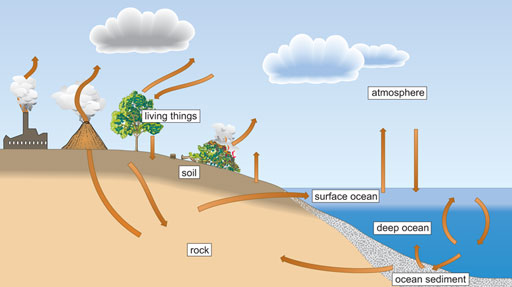
Question 6
In Figure 2 there is an arrow pointing from the atmosphere to the tree (living things). What carbon-containing compound do you think this arrow relates to?
Answer
The compound is gaseous carbon dioxide and it is used by the tree for photosynthesis.
In Figure 2 there are many arrows depicting movement of carbon compounds from one place to another. For instance, when plants and animals die they may get buried in soil and eventually as more material is deposited on top of them, they are buried deep enough to be considered part of the rocks beneath our feet. Thus the carbon has been transferred from the atmosphere to the rock, via animals, plants and soil. This is exactly what happened when fossil fuels such as oil, coal and gas were formed millions of years ago.
The Kyoto Protocol from the United Nations Framework Convention on Climate Change, which came into force in 2005, legally commits countries that signed the protocol to reduce emissions of four greenhouse gases, including CO2. One of the ways in which this could occur is by a shift away from fossil fuels to biofuels, although this view is contentious for reasons indicated shortly. Another is by the process known as carbon offsetting, whereby the amount of carbon released into the atmosphere by burning fossil fuels is balanced, for example by planting a certain number of trees to take up the equivalent amount of CO2 by photosynthesis - so-called carbon sequestration. This has led to the currently used terms 'carbon neutral' (where the amount of CO2 that is produced by an individual or a population is balanced by the amount of CO2 that can be absorbed through various measures taken) and 'achieving a zero carbon footprint' (where the net amount of CO2 released by a person, or by an object such a house, is zero).
Activity 1
In this activity you should listen to the nine-minute audio clip in which Professor Chris Somerville, a global leader in biofuel research, discusses the potential of biofuels, and then answer the following questions.
[You may find it helpful to listen to the clip once, then read the questions before going back to listen to the clip again, pausing where appropriate to make notes.]
Transcript: Audio 1
- What crops did Prof. Somerville think would have the biggest potential for acting as biofuels?
- In his view what are the biggest misconceptions about biofuels?
- What percentage of land worldwide is currently (as of 2010) used for agriculture and what percentage for biofuel production?
- What percentage of their transportation fuel do Brazilians obtain from biofuel sources?
- If the Brazilians scaled up their biofuel production, by intensifying the land used for cattle production, what percentage of the world's transportation fuels does Prof. Somerville estimate that Brazil could produce?
- What is his 'take home' message about the advantages of biofuels over fossil fuels?
- Did Prof. Somerville feel that biofuels are the single answer to the world's diminishing fuel availability, and if not, why not?
Answer
- Perennial crops such as Miscanthus or switchgrass which can produce a large amount of biomass but in a sustainable way. He also has an interest in agave species that are very water efficient, can produce large amounts of sugar and can be grown on land that is too dry for agricultural crops.
- The biggest misconceptions are:
- The net energy return (amount of energy required to grow and process the crop) is greater than the energy that is returned when the fuel is burned.
- Growing some biofuels might actually increase the net amount or carbon dioxide (a greenhouse gas) being released to the environment whilst growing other biofuels might help reduce the amount.
- Also the amount of land that is available and which might be used for growing biofuel crops could threaten food production (which Professor Somerville thinks is entirely wrong).
- About 12% for agricultural use and a tiny (fraction) percentage '0.00 something' % for biofuels.
- About 40%.
- About one third of the transportation fuel (33%).
- They are sustainable and they can have a net positive greenhouse gas effect (take in more carbon dioxide gas than is released when they are burned).
- No. He felt that the world could perhaps get 30% of their transportation fuel through biofuels. However, he felt that a number of other renewable energy sources needed to be used alongside biofuels.
If you are interested in how Professor Somerville became interested in plants and what he does now, you can listen to another (four-minute) audio clip.
Transcript: Audio 2
2.1 Photosynthesis
Box 1 Photosynthesis in plants
Photosynthesis is a complex process that involves the plant using energy from sunlight to combine carbon dioxide gas with water to make sugar. The reaction can be expressed in words as follows:
water + carbon dioxide → sugar + oxygen
The sugar is typically in the form of glucose, but it could be other kinds of sugar, or indeed sugar alcohols. The oxygen that is a by-product of the reaction is essential for all plant and animal life. Photosynthesis occurs inside chloroplasts, which are found in the leaves (and other green parts) of the plant. Chloroplasts contain molecules of chlorophyll, a green pigment that captures energy from sunlight and harnesses it to enable the sugar to be produced. Chemically, plant tissue is mostly made up of compounds containing carbon (known as organic compounds), which are made by a very complex set of chemical reactions from the sugar produced during photosynthesis. Around 44% of the dry weight (that is, weight excluding water) of a living plant is carbon, captured from the air during photosynthesis.
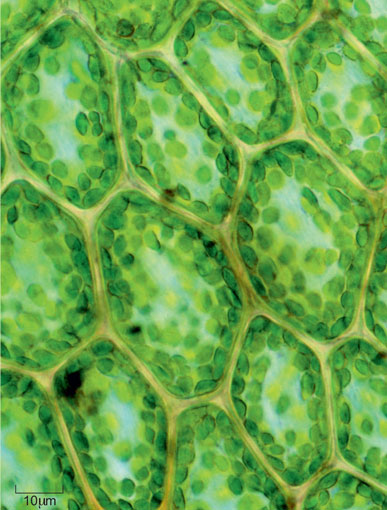
Why are plants green?
An isolated extract of chlorophyll is dark green in colour. Sunlight (white light) comprises all the colours of the rainbow. Chlorophyll absorbs much of the blue and red light that falls on it, but most of the green light is reflected and so can be detected by our eyes. This is why chlorophyll itself and the vast majority of plant leaves appear green. Interestingly, if the photosynthetic pigments absorbed all the colours of light the leaves would appear black and, as black surfaces absorb heat particularly efficiently, plants would probably overheat.
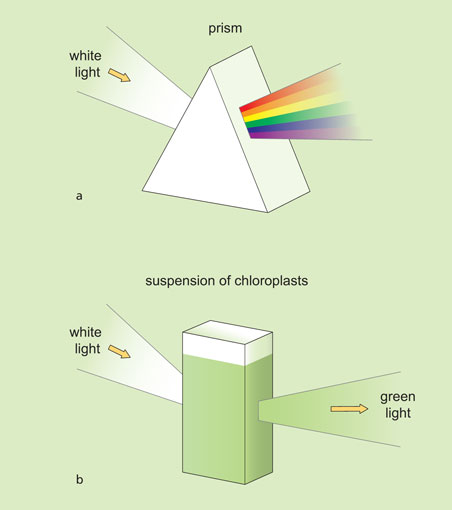
Question 7
On the basis of what you have read so far, summarise the process of photosynthesis in your own words in one or two sentences.
Answer
Photosynthesis is the process by which plants {and also algae and some bacteria} are able to use light energy (from the Sun) to convert carbon dioxide into sugar (carbohydrate) which can then be stored as starch in the plant. The reactions take place within the green parts of the plant, mainly the leaves, which use cells containing chloroplasts.
Plants contain special chemicals called photosynthetic pigments that allow the plant to harvest the light energy.
Question 8
Which of these pigments have you already met?
Answer
Chlorophyll, the green pigment in chloroplasts.
Only a small proportion, around 5%, of the light that falls on a leaf is actually used for photosynthesis. To understand why, Box 2 briefly explains the nature of light.
Box 2 The electromagnetic spectrum
Visible light is composed of a spectrum of colours, as in a rainbow. It is one form of electromagnetic radiation, which is defined as energy in the form of waves that have both electrical and magnetic properties. The electromagnetic spectrum is defined as a series of different forms of radiation which have different wavelengths. Figure 5 illustrates the range of the electromagnetic spectrum and the some of the different ways in which the different forms of radiation within the spectrum have been used. You can see that the range for visible light used for photosynthesis is only a very small part of the overall spectrum.
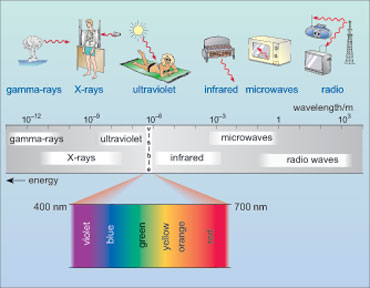
In Figure 5, the value of the wavelength of the electromagnetic radiation is between about 10-12 m and 103 m (that is between 0.000 000 000 001 and 1000 metres).
Question 9
From Figure 5, how does the energy of the radiation vary with its wavelength?
Answer
The radiation with the shortest wavelength has the highest energy. Gamma-rays (wavelength 10-12 m) are very high energy while radio waves (wavelength 1-103 m) are very low energy.
Question 10
Using the information in Figure 5 arrange the following colours of visible light in order of increasing energy: violet, red, orange and green.
Answer
The colour with the lowest energy is red, then orange, then green and finally violet.
Question 11
From Figure 4, which colour of visible light is not absorbed by plants?
Answer
Green light is not absorbed but is reflected, which, as you may remember, is the reason that we can see it and why plants look green.
Question 12
If you have a blue flower, which wavelengths of light are absorbed and which are reflected?
Answer
In order to appear blue, blue light must be reflected and not absorbed - and the other colours of the spectrum including orange, yellow, green and red must be absorbed
The photosynthetic pigments in plants absorb best in certain areas of the electromagnetic spectrum - generally speaking those areas corresponding to visible light and, in particular, the blue and red portions of the visible spectrum.
2.2 The link between energy and biofuels
You may be wondering why there is this emphasis on the electromagnetic spectrum and light absorption by plants in a unit on biofuels. The sugars that the plants produce from carbon dioxide and water are a concentrated form of energy. Energy cannot be created - it can only be converted from one form to another. The energy in sugars comes from the energy in visible light - sunlight. The plant uses the sugars it produces to form other compounds within its tissues and it is these compounds that can be used as biofuels. Box 3 provides describes in more detail the process of photosynthesis.
Box 3 The reactions involved in photosynthesis
Question 13
From what you have learnt so far, where in the plants cells does photosynthesis take place?
Answer
In the chloroplasts.
The absorption of light takes place within specialised membranes within the chloroplasts called the thylakoid membranes (see Figure 6). In order to pack more closely together the thylakoid membranes can form flattened stacks called grana (singular granum).
The reactions of photosynthesis take place in two phases; the absorption of light takes place in the first phase and the second phase occurs in the watery fluid, the stroma, which surrounds the thylakoid membranes. The chloroplast itself is bounded by two membranes that are situated very close together and called the chloroplast envelope (Figure 6).
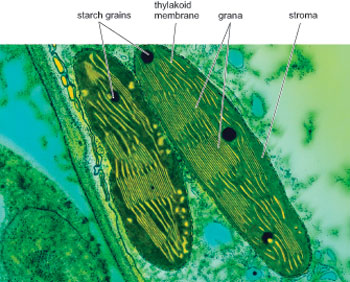
Photosynthesis can be summarised in the simple word equation:
water + carbon dioxide → sugar + oxygen
But this hides the fact that the process consists of two main stages: the so-called 'light reactions' and the 'light independent or dark reactions'.
In the series of very complicated light reactions the energy from sunlight is used to produce two main compounds ATP (which stands for adenosine triphosphate) and NADP.2H (a complicated chemical called nicotinamide adenine dinucleotide). (Don't worry about the names of these two compounds; they are always referred to by their initials.) ATP and NADP.2H are used to convert carbon dioxide, via a complex series of reactions, to sugars - the end point of photosynthesis; these reactions are the dark reactions which take place in the stroma.
Question 14
Why do you think the dark reactions are so called?
Answer
Because the plant does not need the presence of light for these reactions to occur, hence their alternative name - light independent reactions.
Question 15
How does carbon dioxide enter the plant?
Answer
Through small pores called stomata on the leaf surfaces.
The carbon dioxide gas moves (the scientific term for random gas movement is 'diffuses') from a stoma to a chloroplast. There, in a series of reactions that use ATP and NADP.2H, the carbon dioxide binds to a protein called Rubisco (ribulose 1, 5 bisphosphate carboxylase oxygenase) and eventually sugar is produced. Different plants will produce different kinds of sugar but most commonly it is glucose. These processes are summarised in Figure 7. The sugar can then be moved throughout the plant to wherever it is required.
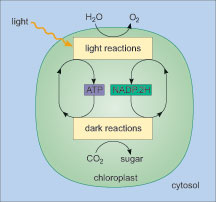
It is worth noting that, as photosynthesis is such a widespread process and Rubisco is so central to it, the amount of Rubisco present in plants worldwide has been estimated to be 25% of all protein globally. You shouldn't have any doubts now as to the importance of the photosynthetic process!
3 Wood as an energy source
The use of wood as fuel for cooking and heating has a long history. In developing countries, 50-90% of fuel used for such purposes comes from either wood or other plant biomass. However, wood is increasingly providing a fuel for electricity generation. The burning of wood is considered to be carbon neutral as it does not release more CO2 into the atmosphere than if the wood were to decompose naturally, although this CO2 is released in a very short space of time.
Woodlands can be managed sustainably to allow appropriate harvesting and replanting; this also provides some local employment and creates a pleasant and enjoyable place to visit. Woodlands also perform a useful function by temporarily storing rainwater, thereby preventing excessive water from entering streams and rivers too quickly. Wood burning also provides an outlet for wood residues from forestry activities which would otherwise end up in landfill sites. There is concern, however, that there will not be enough material to sustain increasing demand for woodfuels.
The process of producing heat and electricity from woodfuel is complex. First, the wood has to be dried, then it undergoes pyrolysis (heating in the absence of oxygen) to produce gases. The gases are then purified and burnt to generate electricity. The ash created during pyrolysis contains nutrients which potentially could provide a plant fertiliser, though it is possible the ash may contain contaminants from the soils in which the trees had originally been growing.
Potential sources of woodfuel are many and include early thinnings from commercial plantations, the residues from timber harvesting and arboricultural activities, coppicing and sawmills. In addition, wood pellets made from highly compressed waste sawdust are gaining in popularity as domestic fuels in the USA and various Scandinavian countries.
Some wood harvesting systems use the whole tree for chipping, while others utilise only the stem wood. In 'short rotation forestry', fast-growing trees are cultivated and grown until they reach what is considered an economically optimum size; the time this takes varies depending on the tree species. The trees are then either harvested or coppiced. Harvesting involves completely cutting down the trees, possibly removing the roots, and then replanting with saplings. In coppicing, the young stems are cut back to encourage a number of new stems to grow from the 'coppice stool'. This can help increase levels of carbon dioxide uptake (carbon sequestration) as the coppice stool re-grows.
Box 4 Short rotation coppice: willow and poplar
Willow (Salix species) and poplar (Populus species) are fast-growing trees, and because they can be densely planted, they give a high yield of wood in a relatively small area. Stems can be coppiced every three to five years and the coppice stools remain productive (produce new stems) for up to 30 years before the root stocks need to be replenished. There is much research interest in short rotation coppicing and the collaborative 'Biomass for Energy Genetic Improvement Network (BEGIN)' have undertaken a number of trials to find varieties and cultivars of willow and poplar species that offer high stem yields, increased growth rates, increased pest and disease resistance and high energy output when burnt.
Establishing willow or poplar plantations has other benefits, such as creating a method of diversification for agricultural land use, increasing biodiversity and providing shelter or screens both for wildlife and against pollution. Willow, in particular, is very good at taking pollutants, including excess nitrate from fertilisers, out of the soil (a process known as phyto-remediation) but this can lead to a high risk of contaminants in the wood.
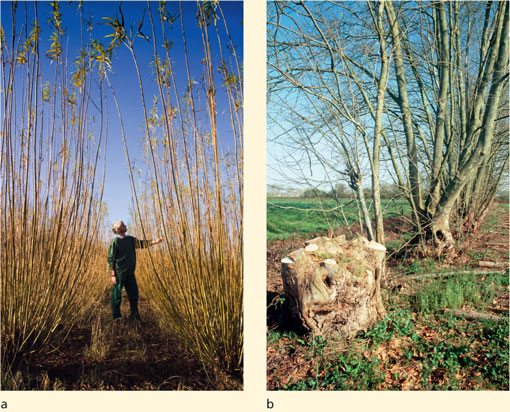
The reason why coppicing works is explained in Box 5.
Box 5 Coppicing
The growth of plants is regulated by various chemical compounds that the plant produces naturally. One such group of compounds are the auxins (plant growth regulators, sometimes called plant hormones). You may have come across 'auxins' as they form the active ingredient in hormone rooting powders that gardeners use to speed up the rate of root production when they have taken cuttings. Auxins are normally produced in the very tip of the shoot and one of their main effects is to prevent side shoots from growing so that all the growth effort of the plant is focused in one main shoot. If the main shoot is damaged or cut off, the source of auxin production is removed so side shoots will then grow. This is exactly what happens when a tree is coppiced, the main shoot (the trunk) is cut off and side shoots (new branches) form. The coppiced stems tend to grow long and straight, mainly because coppiced trees are planted in dense groups or stands (see Figure 8a), and the coppiced side shoots will grow straight up to try and reach the light.
Question 16
If you were planting a species of tree for use as coppice, what characteristics would you be looking for in the tree species you use?
Answer
You would want the trees to be fast growing, capable of growing well when planted closely together and to require little in the way of fertiliser application (which would keep costs down).
4 Grasses as an energy source
There is increasing interest in using grasses as a biofuel source. Grasses grow quickly, produce a large amount of biomass per unit growing area and leave only small amounts of residue when they are burned. Typically, grasses are burned to produce heat and steam to power turbines in conventional power plants. The largest power station in the UK, Drax, currently burns 300,000 tonnes of Miscanthus x giganteus annually, alongside its usual coal supplies. Another advantage of using grasses is that many of them multiply by underground rhizomes, which means they spread quickly and generate new shoots easily. However, this can also make them invasive and difficult to control and eradicate, so they are considered by some to be weeds.
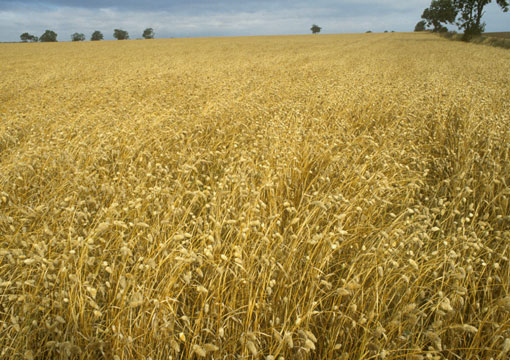
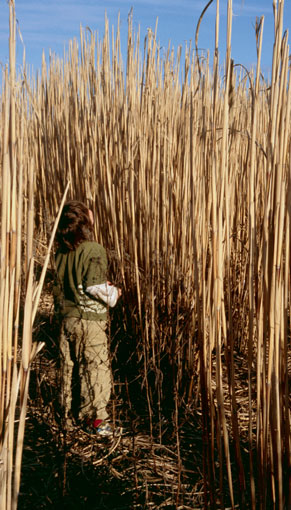
There has been interest in using mixtures of a number of plant species, including grasses, together to produce biofuel. These mixtures allow the maximum interception of light as the different plants grow at different rates. They are considered to be carbon neutral as they are perennials, which do not require re-sowing each year, and, most importantly, they can be sown on degraded agricultural land so food production is not jeopardised.
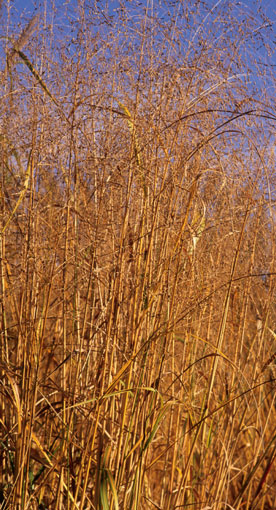
Question 17
Summarise why grasses are particularly suitable for biofuel.
Answer
Grasses grow quickly, they can produce a large amount of biomass in the area in which they are grown and when they are burnt they leave behind relatively small amounts of ash. They are also perennials that spread easily and can grow on poor soil.
Grasses which grow year on year are called perennials. Harvesting of perennial grasses for biofuel can take place anytime from late November to April. The moisture content of the leaves is highest in November meaning that the grass cannot be baled and needs to be chopped into smaller pieces which dry more easily. As time passes from November to April the grass loses leaves, thus reducing the harvestable biomass, but harvesting in April means it can be baled which costs less than chopping the grass up during harvest. Many burners used to generate heat or electricity from wood fuel can also combust bales of grass or straw. Various studies have revealed that it becomes uneconomic to transport grasses for burning as biofuels more than about 80 kilometres.
5 Transport biofuels: biodiesel and bioethanol
Biodiesel is an alternative fuel to diesel, and bioethanol can be used in place of petrol. Biodiesel cannot be used on its own in traditional internal combustion engines but can be blended with traditional petroleum fuel. Bioethanol can be used on its own or in a blend. Overall, biofuels make up 5% of the petroleum blend in the UK. The UK Government set a target that 5% of road transport fuel should be from renewable (non-fossil fuel) sources by 2010.
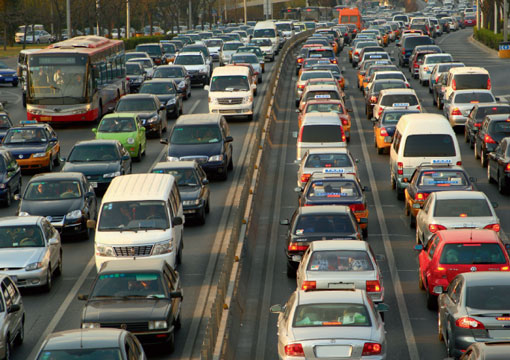
Biodiesel is produced from oil-seed crops, such as oilseed rape, sunflower oil, palm oil and soybean oil. Oilseed rape is the main oil crop in the UK and yields approximately 1300 litres of biodiesel per hectare planted. The fuel is synthesised from the oil seeds by mixing them with two industrially sourced chemicals, methanol and either sodium hydroxide or potassium hydroxide. This reaction causes the formation of fatty acids and glycerol, with the fatty acids reacting further to produce biodiesel. Most biodiesel production is currently in Europe, but it is not limited to the developed world. Tanzania, for example, has started producing biodiesel from the nuts of the croton tree (Croton megalocarpus), a plant native to South-East Asia. Several countries, notably India, are using biodiesel obtained from Jatropha curcas oil as a fuel; indeed the trains that run between Mumbai and Delhi now use diesel that contains 15% biodiesel obtained from Jatropha. This plant has several advantages as a source of biofuel: it can tolerate drought conditions, and it grows on poor land that is unsuitable for agriculture and so does not compete with food production.
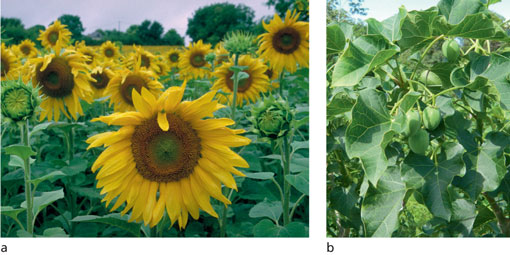
Germany used significant quantities of bioethanol as a biofuel during the Second World War, but recently interest in this fuel source has spread. Currently, countries using bioethanol include Brazil, France, the USA, the UK, Argentina and South Africa. In Brazil use has been particularly widespread; however, this has been at the expense of large tracts of natural vegetation including rainforests. It is estimated that one-third of cars in Brazil run entirely on bioethanol and the remaining two-thirds use a mixture of bioethanol and petrol (gasoline). Bioethanol is produced by fermenting plant sugars, or it can be made by taking starch-rich plant material, treating it to convert the starch to sugars, and then fermenting them. A third, less productive, method is to take stems or leaves and convert the tough cellulose from cell walls into sugars for fermentation; but this requires additional steps, including treating the plant material with sulphuric acid and heating to convert the cellulose into sugars, or using enzymes to do this. Both sulphuric acid and the necessary enzymes have to be produced by industrial means and this incurs an extra cost.
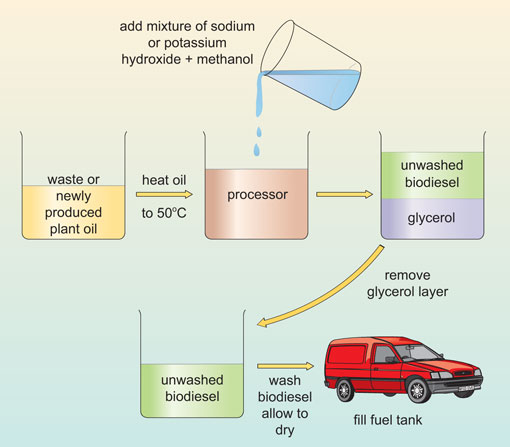
Question 18
List some of the crops used for biodiesel production.
Answer
Oilseed rape, sunflower, palms, soybean, croton tree nuts and Jatropha curcas.
Question 19
Figure 14 shows the stages involved in making biodiesel, summarise these stages in your own words.
Answer
Oil is extracted from the crops and heated to 50 °C in a processor before being mixed with sodium or potassium hydroxide and methanol. The oil is allowed to separate into unwashed biodiesel and glycerol and the glycerol layer is then removed. The biodiesel is washed with water and allowed to dry. The washed biodiesel is stored until it is used.
Question 20
In Figure 15, there is a step labelled fermentation, what is the product of this step?
Answer
The product is bioethanol.
Bioethanol is currently produced by the fermentation of sugar by microbes. Microbes use the sugar as a food source and convert it to ethanol. In order for the ethanol to be used as fuel it needs to be separated from the other components of the fermentation reaction, usually by the process of distillation. Typically the mixture is heated and, as the ethanol boils at a lower temperature than the other components, it is transformed into a gas first and this gas can be collected and then condensed (transformed back to liquid bioethanol). The purified and bioethanol can be mixed with petrol for use in car engines.
6 Biogas
Biogas is mainly a mixture of methane and carbon dioxide produced through the breakdown of organic materials by micro-organisms in the absence of oxygen (that is, under anaerobic conditions). Organic materials can include municipal waste, food and animal waste, sewage, and biomass crops such as switch grass and Miscanthus. Biogas produced in sewage treatment works can be used to generate the electricity to power the works.
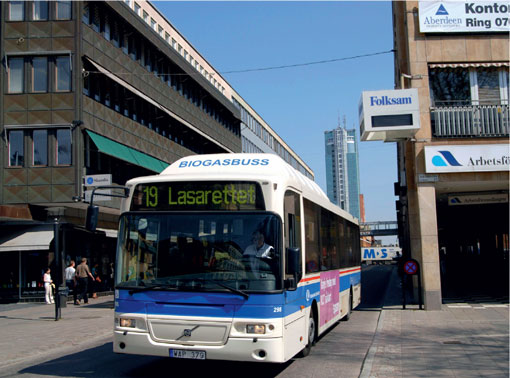
Production of biogas from food waste reduces the amount of this waste that reaches increasingly scarce landfill sites; once the gas has been produced any remaining residue can be used as agricultural fertiliser. Biogas also enables a country to produce its own fuel, rather than being dependent on foreign imports. Sweden is currently the world leader in the use of biogas, having the world's first biogas-powered train which runs the 100 kilometre route from Linkoeping to Vaestervik. Although it is powered by biogas produced from animal waste, there is no reason why in the future such transport could not be powered by biogas produced from plant sources. Buses and rubbish trucks in several Swedish towns also run on biogas.
Question 21
Which of the three biofuels mentioned - biodiesel, bioethanol and biogas - requires the least processing in order to produce it?
Answer
Biogas requires very little processing, whereas the production of both biodiesel and bioethanol requires several processing steps each of which incurs a financial cost.
7 Biofuels: some of the issues
There are many issues to be considered and weighed up regarding the use of biofuels. The following points will help you to consider further the various implications of using trees, food crops and grasses as fuels.
How does the cost of biofuels compare with that of conventional fuels?
At present, the cost of producing biodiesel and bioethanol is approximately double that for conventional fossil fuels. The UK offers tax incentives to encourage fuel producers to make biofuel and there is also an incentive for consumers: the duty on petrol with 5% biofuel is, at the time of writing (2009), 20 p/litre less than that on ultra-low sulphur petrol.
A recent review has shown that biofuel production is a high-cost process overall; only the production of bioethanol from sugar cane was considered to be cost-effective. If, however, the price of crude oil rises then biofuels may start to become more competitive, although this would depend on fertiliser, and hence biofuel feedstock, prices remaining stable.
Does growing crops for fuel create higher food prices?
One point of view is that using land to grow crops for fuel rather than for food has led to increased food prices, which in turn impacts most on those in developing countries who have to spend a relatively large proportion of their income on food. In 2007, the United Nations Food and Agriculture Organisation (FAO) and the International Food Policy Research Institute (IFPRI) both released reports suggesting that rising food prices were due to the conversion of agricultural land from food to biofuel crops. Subsidies for the biofuel industry, quoted to be in the region of £5.6-6.1 billion per year (FAO), are believed to incentivise farmers to grow biofuel rather than food crops. However, those supporting biofuels hold the view that better production methods, which will use parts of the plant currently wasted in biofuel production, may be able to increase the efficiency of biofuel production.
Does growing biofuel crops result in more fertiliser and pesticide input?
The amount of fertiliser and pesticide input depends on the crop species grown; one criterion for a suitable biomass crop is that it has a low requirement for nutrients. Switch grass, for example, grows well in poor soil conditions and requires around two-thirds less fertiliser input than a food crop such as maize.
Is there a potential loss of biodiversity?
In some cases, the use of biofuels could increase biodiversity (the number of different species found within a given area), for example, by harvesting woodfuel and then replanting with mixed woodlands. Conversely, the increased use of soybeans for biofuel in the USA has caused soybean production to be increased in South America at the expense of Amazonian rainforest, which has been cut down to give more agricultural land. This has the potential to reduce biodiversity. Also, trees in rainforests help absorb CO2 (albeit not at the rate of newly planted forests) and so are believed to play a part in offsetting global warming.
Is the energy output greater than the energy input?
The overall energy balance, that is the net energy output compared to the input needed, is dependent on both the species of biomass crop and the type of biofuel being produced. The inputs to a biofuel crop include both the direct costs of growing, such as fertiliser, cultivation, harvest and labour, and the indirect costs, such as storage of the harvested crops. Processing inputs include pre-treatments, processing for energy release and the removal or reuse of residual waste. Ideal crops are being investigated that require low maintenance, need only low nutrients, grow quickly and can tolerate poor soil conditions. Switch grass is one such plant, and interestingly it has been shown that it is only energy efficient if it is used as a pelleted biomass for fuel rather than for bioethanol production.
Do biofuels reduce carbon emissions?
Burning biofuels does release CO2, but this is CO2 that has been removed from the atmosphere relatively recently, unlike the carbon in fossil fuels which has been removed from the atmosphere for many millions of years. Hence, biomass energy crops are deemed carbon neutral. However, some argue that nitrous oxide, which is 240 times more powerful as a greenhouse gas than CO2, is produced in greater quantities during the production of biogas than during the burning of fossil fuels. Also, biofuel production generates CO2 through the use of agricultural and haulage vehicles for growing and transporting the crop.
Question 22
At the start of this course you were introduced to the terms 'carbon offsetting' and 'carbon neutral'. Now that you have finished reading the course, explain in your own words the difference between the terms 'carbon offsetting' and 'carbon neutral' in the context of biofuels.
Answer
When biofuels are grown they take up a certain amount of carbon dioxide from the atmosphere and convert it into stored carbon compounds. When the biofuel is later burnt the carbon in these compounds is converted back into carbon dioxide which is released back into the atmosphere. The amount of carbon dioxide released during combustion is the same as that absorbed during plant growth so on the timescale of years biofuels do not change the amount of carbon dioxide in the atmosphere and so are said to be 'carbon neutral'.
The burning of fossil fuels releases into the atmosphere CO2 that was taken up by plants millions of years ago so increases the total amount of CO2 in the atmosphere. It is possible to calculate the number of new trees that would have to be planted to take up the equivalent amount of CO2 by photosynthesis. Funding the planting of these trees is said to 'offset' the amount of carbon that has been burnt by the use of fossil fuels. For example, when purchasing an airline ticket in 2010, it is possible to offset the carbon cost of the flight by paying for some trees to be planted.
Activity 2
Task 1
In this activity you will listen to the audio slidecast in which Dr Angela Karp from Rothamsted Research discusses some of the issues relating to the use of biofuels in the UK.
Dr Angela Karp works at Rothamsted Research International, the largest horticultural research establishment in the UK. Her research group is particularly interested in looking at those plants species that grow well in the UK but which are not used as agricultural crops. They are investigating the ways of optimising how such crops can be utilised for use as liquid biofuels. Listen to the slidecast and then answer the following questions.
(You may find it helpful to listen all the way through once, then read the questions before going back to listen again, pausing where appropriate to make notes.)
Transcript: Video 1
Question 1
- What type of research is Angela Karp's group doing?
- What are the main difficulties in using woody crops as biofuels?
- Which polymers within the cell wall contain the sugars? What other component of the cell wall makes it particularly difficult to access the sugar-containing polymers?
Answer
- It is investigating woody crops (i.e. non-food crops) to see what their potential is for using as liquid transport biofuels. She is particularly interested in using different types of willow trees and researching how they use the sugar from photosynthesis to produce cell walls.
- The sugars contained within woody crops are locked away as components of the plant cell wall and this can make them difficult to access and to liberate.
- Both cellulose and hemicellulose (which is another type of cellulose) are polymers containing sugars (these sugars are composed of glucose monomers. Lignin is the polymer that made it difficult to access the sugar-containing polymers.
If you would like to know how Angela Karp became interested in plants, you can listen to another short audio clip.
Transcript: Audio 3
Conclusion
Biofuels can be used for heating, lighting, power and transport.
Photosynthesis occurs in the chloroplasts of cells and the process consists of two stages: light and dark reactions.
There are a number of biological products that can be used as biofuels, including wood, grasses, oils, sugars and starches.
Wood and grasses are good biofuels because they grow relatively quickly.
Biodiesel is produced from oil crops, bioethanol is produced from crops with a high sugar content and biogas is produced from the breakdown of organic matter.
Acknowledgements
Course image: Steven Severinghaus in Flickr made available under Creative Commons Attribution-NonCommercial-ShareAlike 2.0 Licence.
Grateful acknowledgement is made to the following sources for permission to reproduce material in this course.
Parts of this text come from Chapter 4 of Why People Need Plants: © 2010 The Board of Trustees of the Royal Botanic Gardens, Kew and The Open University.
Fig. 8a © James King-Holmes/Science Photo Library.
Fig. 8b © Brian Gadsby/Science Photo Library.
Fig. 9 © Dr Rob Stepney/Science Photo Library.
Fig. 10 © Nigel Cattlin/Alamy.
Fig. 11© Andrew Lawson/www.garden-collection.com.
Fig. 12 © Zhang Liwei/Dreamstime.com.
Fig. 13 © Andrew McRobb / RBG Kew.
Fig. 15 (wheat) © George Mastoridis/Dreamstime.com.
Fig. 15 (sugar beet) © Wessel Cirkel/Dreamstime.com.
Fig. 15 (sugar cane) © Andrew McRobb/RBG Kew.
Fig. 15 (sugar) © foodfolio/Alamy.
Fig. 17 © Howard Davies/Alamy.
Every effort has been made to contact the copyright holders. If any have been inadvertently overlooked the publishers will be pleased to make the necessary arrangements at the first opportunity.
Don't miss out:
If reading this text has inspired you to learn more, you may be interested in joining the millions of people who discover our free learning resources and qualifications by visiting The Open University - www.open.edu/ openlearn/ free-courses
Copyright © 2016 The Open University
